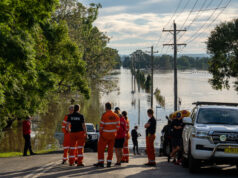Since 2020, the COVID-19 pandemic has caused significant disruptions across global supply chains, leading to shortages of everything from semiconductors to paper.
In 2021, supply chains again came under strain when the container ship Ever Given ran aground in the Suez Canal, creating a logjam of vessels unable to pass through the busy waterway.
But global supply chains face yet another existential threat in the form of the climate crisis.
In 2021, we saw the effects of a changing climate disrupt supply chains around the world in the form of a series of extreme weather events.
In February, an extreme cold snap in Texas caused the worst involuntary energy blackout in US history. As a consequence, three major semiconductor plants closed, “exacerbating a global pandemic-triggered semiconductor shortage and further slowing production of microchip-dependent cars”, writes Jacques Leslie in an article in Yale Environment 360.
Flooding and drought disrupted shipping on the Rhine River in Europe before Hurricane Ida, the fifth-costliest hurricane in US history, struck the Gulf Coast in August. It damaged “vital industrial installations that generate an array of products, including plastics and pharmaceuticals, and forcing a diversion of trucks, already in short supply across the country, for use in relief aid”, notes Leslie.
Fires in British Columbia, a typhoon in Malaysia and flooding in China added to the strain on global supply chains.
These weather-related disruptions are expected to worsen over time. A McKinsey Global Institute report found, for example, that the probability that heavy rare earths production – currently concentrated in south-eastern China and “critical in aerospace and defense, electric vehicles, wind turbines, drones, medical appliances, and other electronics” – is severely disrupted as a consequence of extreme rainfall may increase two to three times by 2030, while the risk of a hurricane disrupting semiconductor supply chains may grow two to four times by 2040.
Most solutions require considerable capital investment, such as expanding inventories, establishing dual networks, investing in supplier resilience and constructing disaster-proof plants.
“Supply chains and the infrastructure that supports them are designed for a stable climate,” states the McKinsey Global Institute report. “As hazards evolve, it will be necessary to increase investment in adaptation, possibly at the expense of efficiency.”
The impact of rising sea levels
In a warming world of rising seas, seaports – critical nodes in global supply chains – are particularly vulnerable.
The global sea level has risen by more than 20 centimetres since the 1880s. Two factors contribute to rising sea levels: the influx of meltwater from glaciers and ice sheets, and the thermal expansion of seawater as it warms.
Not only is the sea level rising, but it’s rising at an ever-increasing rate. According to climate.gov, the sea level rose 3.6 millimetres per year from 2006 to 2015, 2.5 times the average rate of 1.4 millimetres per year throughout most of the 20th century. By the end of the 21st century, the global mean sea level is predicted to rise at least 30 centimetres above 2000 levels.
Positioned on the frontlines of the climate crisis, ports have three broad options available in managing sea level rise, all of which, argues Leslie in Yale Environment 360, are inadequate.
Authorities can shift a port to “inland locations with river links to oceans”, observes Leslie; however, “available sites with requisite conditions are few and expensive”.
Sea dikes form another option – “but even if the dikes are strong enough to resist the rising ocean, they must continually be raised to keep up with sea level rise, and only buy time until eventually being overtopped. They also divert floodwater to nearby coastal areas unprotected by the dikes.”
How to strengthen supply chains
A study looking at supply chain management and climate resilience found that just 11 per cent of sites surveyed in the US, China and Taiwan were fully prepared for climate-related disruptions.
In a study published in the Harvard Business Review, the authors outline a range of strategies to create climate-ready supply chains, starting with preparedness.
The first step is to map the supply chain in depth – including direct and indirect suppliers involved in production, warehousing, transportation and repair – and update the data on costs, risks, delivery times and carbon footprints of each supplier.
It is necessary to assess each site for risks, including “its vulnerability to a local natural disaster, local economic indices, geopolitical risk factors (safety, security, corruption), proximity to suppliers and customers, access to stable energy sources, availability of natural resources [and] long-term labour”.
Preparedness extends to scenario planning. “Conduct simulations of how extreme climate-related events will affect your supply chain,” write the authors. “Such exercises can be invaluable for developing playbooks for responding to various scenarios and can help executives analyze and compare different supply-chain-network configurations and sourcing options to manage climate risk more effectively.”
Draw on the data and insights garnered from research to design a climate-resilient supply chain footprint underpinned by early-detection systems. “Climate monitoring and predictive systems have become essential to running a globally dispersed supply chain.”














